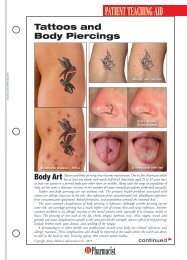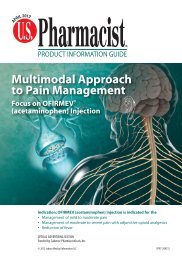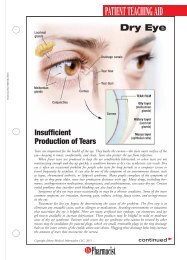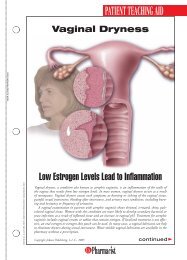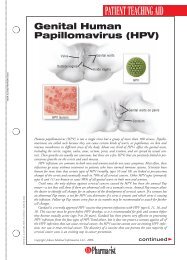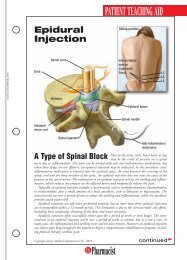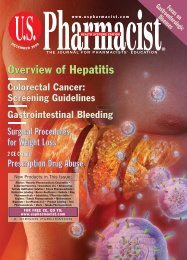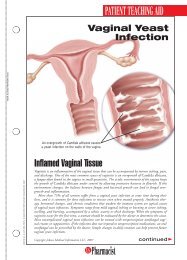View PDF Edition - U.S. Pharmacist
View PDF Edition - U.S. Pharmacist
View PDF Edition - U.S. Pharmacist
You also want an ePaper? Increase the reach of your titles
YUMPU automatically turns print PDFs into web optimized ePapers that Google loves.
TRAUMATIC BRAIN INJURYneurological scale used to assess level of consciousness)less than 10; cortical contusion; depressed skull fracture;subdural, intracerebral, and epidural hematoma;penetrating head wound; or seizure within 24 hoursafter injury. 14Phenytoin and valproate sodium have been studiedin the prevention of early and late PTS. Onestudy cited by the 2007 guidelines showed a significantreduction in early PTS without showing any significanteffect on late PTS or survival with the use ofphenytoin. 14 In contrast, a randomized, double-blindstudy showed no early or late PTS benefit by usingphenytoin. Valproate sodium has shown a similar rateof early PTS reduction when compared to phenytoin.However, a trend toward higher mortality in the valproatesodium group was noted and could be cause forconcern. 14Since the publication of the guidelines, there havebeen two pertinent studies completed regarding seizureprophylaxis. 15-16 The first, a study from 2008, comparedthe incidence of seizures in patients with TBIwhen randomized to either phenytoin or levetiracetam. 15Results indicated that there was no significant differencein seizure incidence. However, patients receivinglevetiracetam showed increased incidence of electroencephalogram(EEG) abnormalities. An EEG was indicatedif patients displayed persistent coma, decreasedmental status, or clinical signs of seizures.The second study evaluated the incidence of latePTS in patients with TBI who did or did not receiveantiseizure prophylaxis upon initial presentation. 16This study was carried out in Italy, with phenobarbitalbeing one of the main agents used in antiseizureprophylaxis. Interestingly, in the retrospective portionof the study, 29% of patients who received antiseizureprophylaxis developed late PTS, while only 13% ofpatients who did not receive prophylaxis developedlate PTS. While the retrospective data were not statisticallysignificant, the prospective data were evenmore striking. A significant difference was noted inthe prospective group, where 39% of patients treatedwith antiseizure prophylaxis developed late PTS, whilenone of the patients who were not treated with antiseizureprophylaxis developed late PTS. However, phenobarbitalis not commonly used in the U.S. in thisregard because of its adverse-effect profile and multipledrug interactions, and because more appropriateantiepileptic selections are available; therefore,results must not be generalized too drastically.In summary, current literature including the 2007guidelines indicates that the incidence of early PTSappears to be reduced with the addition of prophylacticantiseizure medications. 14 However, there is currentlyno evidence to indicate that prophylactic antiseizuremedications alter mortality or incidence oflate PTS, and it is still unknown whether or not thiscourse of therapeutic prophylaxis is currently benefittingpatients.ConclusionTraumatic brain injury can be overwhelming and distressingto both patients and their family members. Inaddition to the emotional and social impacts that accompanyTBI, it is important to identify and deliver promptattention to the physical needs of the patient. Prophylacticmedications play an important role in patientswith TBI, yet as of now many categories lack definitivedata to direct appropriate therapeutic choices. Futurestudies are needed to clarify this important issue inthe management of patients with this condition.HEALTH SYSTEMS EDITIONREFERENCES1. Langlois JA, Rutland-Brown W, Thomas KE. Traumatic Brain Injury inthe United States: Emergency Department Visits, Hospitalizations, and Deaths.Atlanta, GA: Centers for Disease Control and Prevention, National Centerfor Injury Prevention and Control; 2006.2. Nolan S. Traumatic brain injury: a review. Crit Care Nurs Q.2005;28:188-194.3. Faupel G, Reulen HJ, Muller D, et al. Double-blind study on the effectsof steroids on severe closed head injury. In: Pappius HM, Feindel W, eds.Dynamics of Brain Edema. New York, NY: Springer-Verlag; 1976:337-343.4. Gobiet W, Bock WJ, Liesgang J, et al. Treatment of acute cerebral edemawith high dose of dexamethasone. In: Beks JW, Bosch DA, Brock M, eds.Intracranial Pressure III. New York, NY: Springer-Verlag; 1976:231-235.5. Brain Trauma Foundation, American Association of NeurologicalSurgeons, Congress of Neurological Surgeons, et al. Guidelines for themanagement of severe traumatic brain injury. XV. Steroids. J Neurotrauma.2007;24(suppl 1):S91-S95.6. Roberts I, Yates D, Sandercock P, et al. Effect of intravenous corticosteroidson death within 14 days in 10,008 adults with clinically significanthead injury (MRC CRASH trial): randomised placebo-controlled trial.Lancet. 2004;364:1321-1328.7. Brain Trauma Foundation, American Association of NeurologicalSurgeons, Congress of Neurological Surgeons, et al. Guidelines for themanagement of severe traumatic brain injury. IV. Infection prophylaxis.J Neurotrauma. 2007;24(suppl 1):S26-S31.8. Stoikes NF, Magnotti LJ, Hodges TM, et al. Impact of intracranial pressuremonitor prophylaxis on central nervous system infections and bacterialmulti-drug resistance. Surg Infect (Larchmt). 2008;9:503-508.9. Denson K, Morgan D, Cunningham R, et al. Incidence of venousthromboembolism in patients with traumatic brain injury. Am J Surg.2007;193:380-384.10. Brain Trauma Foundation, American Association of Neurological Surgeons,Congress of Neurological Surgeons, et al. Guidelines for the managementof severe traumatic brain injury. V. Deep vein thrombosis prophylaxis.J Neurotrauma. 2007;24(suppl 1):S32-S36.11. Cothren CC, Smith WR, Moore EE, Morgan SJ. Utility of once-dailydose of low-molecular-weight heparin to prevent venous thromboembolismin multisystem trauma patients. World J Surg. 2007;31:98-104.12. Norwood SH, Berne JD, Rowe SA, et al. Early venous thromboembolismprophylaxis with enoxaparin in patients with blunt traumatic braininjury. J Trauma. 2008;65:1021-1027.13. Reiff DA, Haricharan RN, Bullington NM, et al. Traumatic brain injuryis associated with the development of deep vein thrombosis independent ofpharmacological prophylaxis. J Trauma. 2009;66:1436-1440.14. Brain Trauma Foundation, American Association of NeurologicalSurgeons, Congress of Neurological Surgeons, et al. Guidelines for themanagement of severe traumatic brain injury. XIII. Antiseizure prophylaxis.J Neurotrauma. 2007;24(suppl 1):S83-S86.15. Jones KE, Puccio AM, Harshman KJ, et al. Levetiracetam versus phenytoinfor seizure prophylaxis in severe traumatic brain injury. Neurosurg Focus.2008;25:E3.16. Formisano R, Barba C, Buzzi MG, et al. The impact of prophylactictreatment on post-traumatic epilepsy after severe traumatic brain injury.Brain Injury. 2007;21:499-504.HS-19U.S. <strong>Pharmacist</strong> • November 2009 • www.uspharmacist.com




